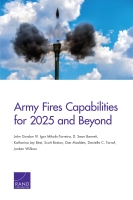by John Gordon IV
What are the currently planned and programmed fires capabilities of the Army and other services?
What are the likely conventional threats that U.S. fires units can expect to confront, both in terms of hostile intelligence, surveillance, and reconnaissance (ISR) and counterfire threats to U.S. artillery and joint fires systems and in terms of targets that the Army and joint fires will be expected to engage?
What fires capabilities will the Army require to meet these threats?
What actions should the Army consider taking from today to roughly 2030 to strengthen the field artillery?
From early 2002 until early 2016, the Army focused primarily on counterterrorism and counterinsurgency operations, and the field artillery branch saw considerable reduction of its force structure and a commensurate cut in modernization funding. By late 2016, aggressive moves by Russia against Crimea and Ukraine, fear of Russian coercion against the Baltic nations, an expanding Iranian military, and rapidly growing Chinese military capabilities had contributed to a change in focus, and the Army was in the process of reorienting back to conventional combat against the armed forces of another nation-state. This shift highlighted the need to take a detailed look at the state of the field artillery, long a key branch of the service when conventional combat capabilities are required.
This study focused on examining the types of capabilities that Army field artillery will need in future operations from the present into the early 2030s. The authors examined several illustrative scenarios to determine the threats that field artillery units will encounter and the types of missions the artillery will be expected to perform in the future. The authors identify the types of capability gaps that may be present in today's field artillery and recommend courses of action that the Army might take to fill those gaps and better prepare the artillery for future missions. Because virtually all operations today are joint, the study also examined the current and emerging capabilities of the other services, and the authors' recommendations on how to improve Army field artillery take into account what the Air Force, Navy, and Marine Corps can contribute in terms of air-to-ground and surface-to-surface fires.
Key Findings
In a potential future conflict with Russia, U.S. ground fires would face a variety of challenges, including being outranged and significantly outnumbered, limitations the Russians can impose on U.S. target acquisition systems, the complexity of coordinating joint fires, and the need to preposition heavy equipment and ammunition.
In a potential future conflict with North Korea, an important capability gap is the field artillery's lack of munitions capable of penetrating well-constructed underground positions, from which North Korean cannons and rocket launchers can fire and rapidly return to.
In a potential future conflict with Iran, challenges include the need for significant amounts of accurate, long-range fires across the Persian Gulf and Strait of Hormuz and potentially difficulties in coordinating with other Gulf States.
In a future conflict with the Islamic State of Iraq and the Levant or similar organization, challenges include the need for highly precise targeting and munitions to provide fire support in urban areas without causing excessive collateral damage.
In a future conflict with China, U.S. ground fires would require a much longer-range fire system than any the Army currently fields, as well as an anti-ship capability.
Recommendations
Increase the number of field artillery units that can deploy quickly to a crisis or that are located forward, where the fast arrival of U.S. forces is essential; this is likely to require force structure increase for the active Army field artillery units and/or changing the readiness status of some National Guard field artillery units.
Improve the Army's ability to quickly get and utilize intelligence, surveillance, and reconnaissance data from the other services.
Modernize the Army's cannon systems, particularly in terms of range and rate of fire.
Ensure that there is a timely and adequate replacement for the Army Tactical Missile System (ATACMS).
Improve Army ground forces target acquisition capabilities.
Improve the artillery's ability to provide fire support to allied and coalition partners.
Enhance the field artillery's electronic warfare (EW) and cyber resilience.
Reduce the artillery's vulnerability to enemy fires through reduced exposure to EW targeting, improved mobility, and use of camouflage and decoys.
Improve the survivability of artillery units against enemy indirect fire, airborne, and ground threats.
Emphasize major conventional opponents in field artillery, combined arms, and joint training exercises.
Examine the possible use of foreign fires systems that may be have utility to the field artillery.
Continually assess technology trends that could improve the effectiveness of field artillery units.

No comments:
Post a Comment